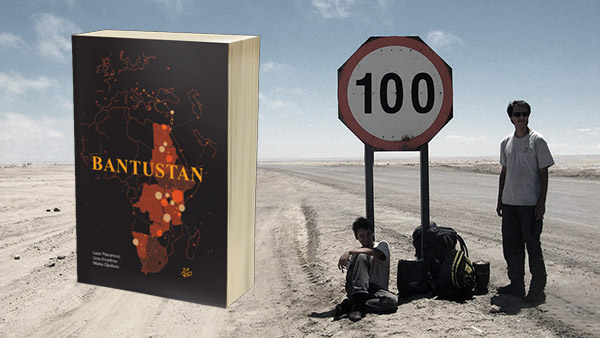This condensed travelogue relates the experience of a 30-day railway journey around China. It was written while returning from that journey, on another train - the Trans-Siberian.
If you decide to conquer some of the gigantic distances in China via train, you’ll have four different classes to choose from. If you yearn for full comfort - and your wallet hasn’t been on a diet lately - you’ll have access to the comfy (so they say) “soft sleeper”. For those with fewer cares, but who still wish to enjoy the passing Chinese landscapes in a relatively outstretched position, there’s the “hard sleeper”, which resembles the Russian platzkartny, but has three-level berths. For shorter distances, in some newer trains, you may find the “soft seats” as well.
Nevertheless, the most likely choice of every Chinese or low-budget foreign traveller, regardless of the length of the trip or the chosen destination, will be the famous “hard seats”. If worst comes to worst, there's the standing ticket as well, adding to the unique atmosphere of the Chinese train, which we’ll try to convey in detail.

To get your hard seat you’ll have to accomplish some rather challenging tasks. First of all, you’ll need to buy a ticket. Secondly, there’s the no less complex operation of boarding the train.
After having thoroughly toured the railway station’s main building, followed by all the auxiliary and appended buildings as well as some sheds and shanties, with many fingers pointing in different directions, you’ve finally found a window where you can buy a ticket to your destination. The ticket window is a venue of diverse verbal and physical battles. It seems that, in China, it’s a matter of honour to get your hands on the ticket before anyone else, and the last to get one will probably face the most horrible consequences, judging by the combat in which all means are justified for getting the much-desired piece of pink paper. If you accept the fact that here you'll either eat or be eaten, you can exercise creativity in competing with the throng that keeps creeping under your armpit, throwing money over your head, shouting something at the top of their voices, and not sparing their elbows in your kidneys. We recommend a combination of the following methods: heartless pushing (it's easy, why not use the fact that you're bigger?), digging your feet in (legs slightly astride provide you with better stability, and the hand luggage, such as a bag, increases your width and additionally defends your position), defence (unfolding a large map is the ultimate defence from wing attacks - we recommend the map of former Soviet Union, which is just about big enough to form an obstacle between you and the ticket window on one side, and the enemy on the other). Now all that’s left to do is to make sure you haven't forgotten to make a sacrifice to Gods of Communication, and you’ll be triumphantly waving your ticket before the defeated eyes of those surrounding you.
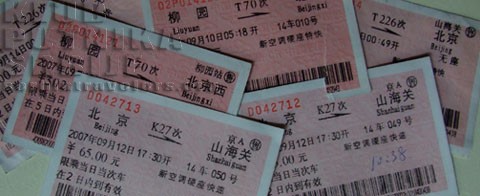
The next stage consists of finding the carriage with the corresponding number. Your ticket says, loud and clear: one. You glance at the carriage in front of you - 16. Left - 17, right - 15. Ok, that's clear. You walk following the descending numbers, past the huge Chinese carriages, six, five, and further, until you've finally reached the number one, proudly showing your ticket to the attendant. No, no, it’s not here. You look at your ticket - 1, you look at the carriage - shiny navy blue paint on a white plate says - 1. You draw the attendant's attention to this uncanny coincidence, but he is unrelenting. No, no, go, he waves his hand in the direction of the other end of the train, whose outlines you can vaguely make out somewhere in the mist. Your Western mind protests, that's where the bigger numbers are, and you're trying, but the finger is still pointing at the direction in which you are to get lost. You shrug, glance sheepishly at the ticket, then at the carriage number, then at the clock mercilessly devouring minutes left till departure, and then you grab your bag and start running back. Nine... ten... eleven... this is where you started from... seventeen...
They won't let you inside, to continue your search for the carriage in the safety of the train corridor. Finally, all sweaty and breathing heavily, you find an unmarked carriage safely tucked between carriages number 19 and 20. That’s it, they are absolutely sure. Number one mocks you from the ticket as you give up thinking about the eastern systems of logic and start getting acquainted with your current habitat.
Train Design
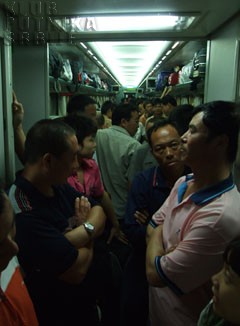 One couldn’t say that Chinese relied on the rules of feng shui when they designed their trains. In fact, there are many indicators that the designer was someone who had little need for movement in their life. Seats are lined in three-to-three formations, with the space between opposite seats of approximately 40 centimetres, obstructed by a tray table that can’t be stowed. The height of the tray barely allows you to put your legs underneath, which is possible only if you employ the oblique manoeuvre. At the level of your shins there’s a conveniently placed shelf that can be used to additionally crush your legs, reinforcing the sneaking suspicion that the designer was a bitter opponent of blood circulation in limbs. The experience of the hard seats’ duly justifies their name, ergonomically keeping your body in the upright posture, which is not too bad if you wish to refine your ability to sleep in non-standard positions, on surfaces of various shapes and degrees of solidness.
One couldn’t say that Chinese relied on the rules of feng shui when they designed their trains. In fact, there are many indicators that the designer was someone who had little need for movement in their life. Seats are lined in three-to-three formations, with the space between opposite seats of approximately 40 centimetres, obstructed by a tray table that can’t be stowed. The height of the tray barely allows you to put your legs underneath, which is possible only if you employ the oblique manoeuvre. At the level of your shins there’s a conveniently placed shelf that can be used to additionally crush your legs, reinforcing the sneaking suspicion that the designer was a bitter opponent of blood circulation in limbs. The experience of the hard seats’ duly justifies their name, ergonomically keeping your body in the upright posture, which is not too bad if you wish to refine your ability to sleep in non-standard positions, on surfaces of various shapes and degrees of solidness.
Once you find yourself in a carriage, you’ll realize that every single person in China has made the urgent decision to board exactly the same train as you. Efficiency is obtained by boarding about 30% more people than is theoretically possible, given the limited volume of the carriage. Without paying much attention to the laws of nature, passengers carry their luggage in amounts sufficient to supply all the Chinatowns in Europe and beyond, and then, when it has long become impossible to add anything, they bring in yet more, and the train assumes qualities of a black hole that sucks in everything that approaches it. It’s best to surrender completely, and blend yourself with the indistinguishable conglomeration of plastic bags, arms, girls’ braids, empty shoes and God-knows-what-else, in order to completely savour the following 36 hours of your life.
After all, it seems like everybody is pleased with this atmosphere, chatting merrily, singing along, laughing (especially when they spot you, the foreigner), and endlessly wandering to and fro, from one end of the carriage to another, in the search of the toilet, samovar, or smoking place, which makes you feel like you’ve ended up in the centre of a cauldron of boiling hotchpotch.
The Carriage Crew
No carriage is left to its own devices, and certainly nothing is left to double-dealing chance. In the first couple of hours, you’ll become one with the caring railway family, there to see to your and other passengers' comfort.
The most agile one is the Man With a Little Broom, who paces the train in pursuit of a rebellious crumb that deviously crawled between the legs of twenty passengers stacked on two square meters, on a mission to undermine Chinese sanitary standards. For the Man With a Little Broom there are no obstacles, and no matter how clear the floor might seem, he’ll discern the anarchically-inclined crumb, and no matter how much luggage – or people - might be in the way, his little broom will scrape through and sweep away the enemy of every honest railway employee.
 The Man With a Garbage Bag fights for the ideals similar to those of the Man With a Little Broom. You’ll know him by a huge black bag that he pushes under your nose, so that you can unload your waste. The Man With a Garbage Bag is, however, not gullible; he knows that an unwary passenger will surely omit a cunning piece of garbage, so he personally peeps under the seats and between legs, moves carefully stacked bags and, once more, just in case, shakes the seemingly empty trays into the bag, before resuming further down the path of his struggle.
The Man With a Garbage Bag fights for the ideals similar to those of the Man With a Little Broom. You’ll know him by a huge black bag that he pushes under your nose, so that you can unload your waste. The Man With a Garbage Bag is, however, not gullible; he knows that an unwary passenger will surely omit a cunning piece of garbage, so he personally peeps under the seats and between legs, moves carefully stacked bags and, once more, just in case, shakes the seemingly empty trays into the bag, before resuming further down the path of his struggle.
Awareness of the elevated hygiene standards is obviously well-developed with the Chinese travellers, since spitting on the floor is not performed lightly; the unwritten rules clearly state that the spit should be carefully embedded into the carpet with the sole of one’s shoe.
A unique phenomenon in the world of the Chinese train is the Man Who Takes Care of the Curtains. It’s well known that neatly aligned curtains are the best indicator of sophisticated aesthetic feeling, for which the Chinese are widely renowned. It is also known that the curtains have a disposition such that they crumple and move and hardly anyone can really keep them in check. Finally, even the dogs in the streets know that at night, during bedtime, the curtains have to be drawn, whilst in the morning, with the first break of the dawn, they have to be pulled in order to let the cheerful sunbeams inside to dance on the faces of slumbering passengers. That no omission should be made in this carefully planned sequence, the Man Who Takes Care of the Curtains is there to take care of it for you. Assiduous and steadfast, he won't stop short of waking you up, pulling the curtain into the optimal position, and smilingly gesturing to you that you’re free to resume your sleep, of course as long as you don't disturb the symphonious state of the curtains…
In its long ride over the tracks, the train rocks and sways. In this rocking, stopping and departing, it sometimes happens that a belt of a bag loosens, falls and starts dangling from the overhead luggage compartment. Since in the Chinese train this is considered a bad omen, the Man In Charge Of Dangling Belts is always alert and ready to rush and fix this mess.
 The Man With a Hat And a Carriage Number Plate is a symbol of order and discipline on the Chinese train. He appears every time the train approaches a station. The moment the train starts decelerating and coming to a standstill, the Man uses one hand to grab his hat and the other to support himself while jumping over heads of the passengers piled on the floor, at the same time shouting his head off about what you can only assume is the name of the town at which you’re arriving. He then opens the door, hangs a carriage number plate onto a specially designed place (very useful, as mentioned above), and assumes a dignified “ATTENTION” posture whilst the passengers from the train are falling over him, the new ones from the platform trying to stuff their luggage inside simultaneously.
The Man With a Hat And a Carriage Number Plate is a symbol of order and discipline on the Chinese train. He appears every time the train approaches a station. The moment the train starts decelerating and coming to a standstill, the Man uses one hand to grab his hat and the other to support himself while jumping over heads of the passengers piled on the floor, at the same time shouting his head off about what you can only assume is the name of the town at which you’re arriving. He then opens the door, hangs a carriage number plate onto a specially designed place (very useful, as mentioned above), and assumes a dignified “ATTENTION” posture whilst the passengers from the train are falling over him, the new ones from the platform trying to stuff their luggage inside simultaneously.
The Woman With Lunch, Woman With Fruits and Woman With Refreshments are there to see that no one goes hungry. They manage to do the impossible – pushing their carts with goodies through the eye of a needle, a corridor that even a kid can’t squeeze through - demonstrating remarkable skills that should earn them worldwide fame. Yet, we suggest admiring from a distance, as you don’t want to get in the way of their wheels. Long after they’ve gone, you’ll still be staring, awed, in their direction - that is, into a couple of centimetres of visibility between you and the human wall whose headcount and steadiness would defend a besieged fortress.
Last but not least, there is the Woman With a Counter. At her little throne in the corner of the carriage she manages the greatest valuables of Chinese Train – reservations. With a little luck, a couple of seats in different classes may be vacated over the course of the trip. That event equals to winning the jackpot on the lottery, even though for getting the reservation you don’t need luck, but the skill of a war veteran. If you find the trip monotonous, you can always choose your favourites and cheer passionately for them to get the longed-for transfer.
Entertainment
The railway personnel's care for their passengers never stops. In order to make your long hours shorter a diverse program has been devised - a young man in a woman's vest, adorned with the most garish bling, appears on the scene balancing on the one square millimetre of free space he managed to snatch up; with a loud guttural cry he grabs the attention of all the passengers, starts waving his hands and, contorting his entire body, peddles knickknacks to the ladies with a charming smile and incomprehensible shrill cries, parading and cracking jokes that make all the attendees burst into laughter; all this is followed by theatrical haggling - a display worthy of the New Year’s Eve special on national television in any post-communist country.
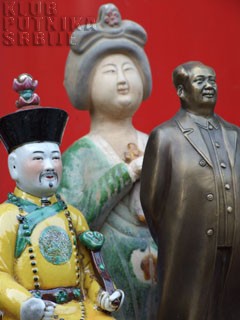
Similar in style and even more so in decibels is the sketch with memorial medallions (gold, 24 karat) with Mao’s portrait and the scenes from Chinese railway history. There is also a presentation of dynamo torches which create a subtle sound, very much resembling that of a dying engine. The entertained passengers are allowed to test the torches themselves, so each passenger takes a flashlight that twinkle in the rhythm of Chinese opera, while the vendor’s voice proves that he could perform the same spectacle even in the crowded Tiananmen, with no sound system to support him.
Nutrition
One cannot, as we all know, survive on entertainment alone. Part of the mystery of the oversized luggage that every citizen of the People's Republic carries on board is resolved a couple of minutes into the ride, with the beginning of the railway’s nutritional orgies.
Chinese cuisine is famous for its variety and complex rules of combining ingredients according to climate conditions, aesthetic principles and philosophical concepts of Yin and Yang. Practical reasoning has tailored the menu to perfectly meet the conditions of a long railway journey. Staple train diet in China consists of instant noodles (similar to Russian lapsha) and juicy, spicy sausages.
The noodles are found in a plastic container, together with several sachets of various sauces. All these are mixed together using boiling water from samovar. A couple of minutes later you’ll have a hearty portion of seriously hot food that qualifies you as a competitor in loud slurping, surroundings-spraying contest the other passengers are engaging in. Unavoidable sausages rolled in hot pepper enrich the flavour (in case there’s a single unburnt taste bud left on your tongue after savouring the sauce). The sausages come single-packed and ready to eat, so the passengers use them as snacks between the meals. The sausage-and-noodles ritual is repeated time and time again during the day. Producers of these goods probably turn enough profit in a day for a long, lazy vacation in a glitzy resort.

Apart from the sausages, there are different kinds of processed meat available during the trip instead of (in this country rare and somewhat tasteless) sweets and finger food. You can choose from a selection of chicken legs, kebabs of unidentified origin, chicken drumsticks eaten like ice cream and, especially for gourmets, marinated pig snouts. Meaty treats are eaten between noodles and more noodles, and the whole process continues without a break. The air is filled with thick, spicy smells and the happy munching and gnawing never ends.
In this environment, you had better not have made a mistake, calculating the duration of the trip to be two hours instead of almost six, and thus neglecting to bring any food with you. While on some other train you might be able to get away with it, on this one you’ll immediately start starving to the point when even the umpteenth chicken leg your neighbour is devouring starts looking like a most delicious treat. Luckily, there’s always one of the Women With Carts around who will, running over everything in front of her, enable you to quickly and efficiently join in the collective munching.
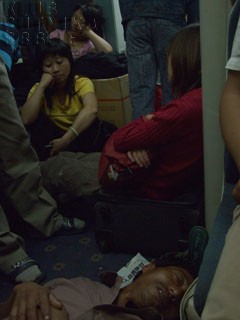 Shuteye
Shuteye
Short breaks between meals are filled with the favourite on-train activity: sleeping. It might look as if you’ve strayed into a train that transports circus acrobats and rubber people able to rest in improbable positions, while snoring champions compete in their prowess. You’ll soon realize that on the Chinese train everything is possible, and that all this is perfectly normal, even pleasant, as you calmly doze off, crouched, with one leg high in the air and your head wrapped around the toilet door handle...
Alighting
You’ll quickly notice that the journey is coming to an end when a feverish haste of the Man With a Little Broom and the Man With a Garbage Bag compels impatient passengers to spring to their feet. This starts the flurry of activity consisting of moving around all the sacks, bags, gigantic plastic parcels, boxes wrapped in insulation tape, etc., to the corridor, right at the carriage door. Even for the Chinese train this is a challenging task, and the bustle lasts for approximately half an hour before all the human beings and luggage from the carriage has been compressed and stacked to block the exit.
The Man Now Without a Little Broom begins to pull the carpet from under the feet of the crowd, removing it magically despite the hundreds of kilograms piled on it. The rolled carpet now triumphantly obstructs the way between you, a bunch of huddled passengers, and your chance to ever find yourself outside. However, that shouldn’t concern you. One glance at the watch will assure you that, even though everyone is ready to rush out at any moment, there’s more than one hour left to the next stop. You may use this hour of standing in the corridor as an opportunity to thoroughly reflect upon the miraculous world of the Chinese train.

